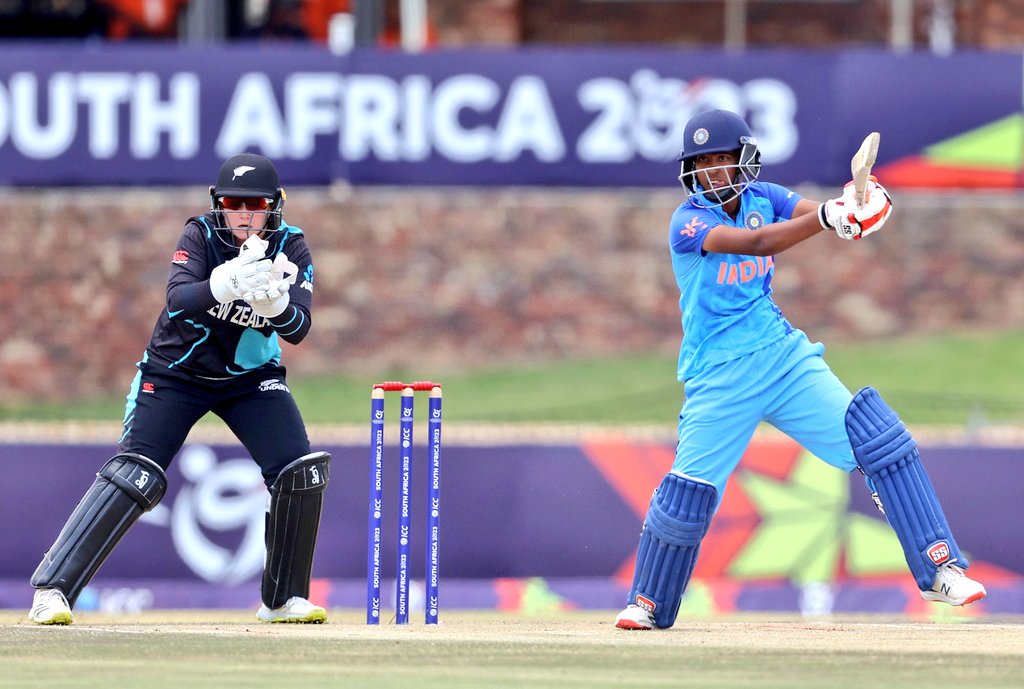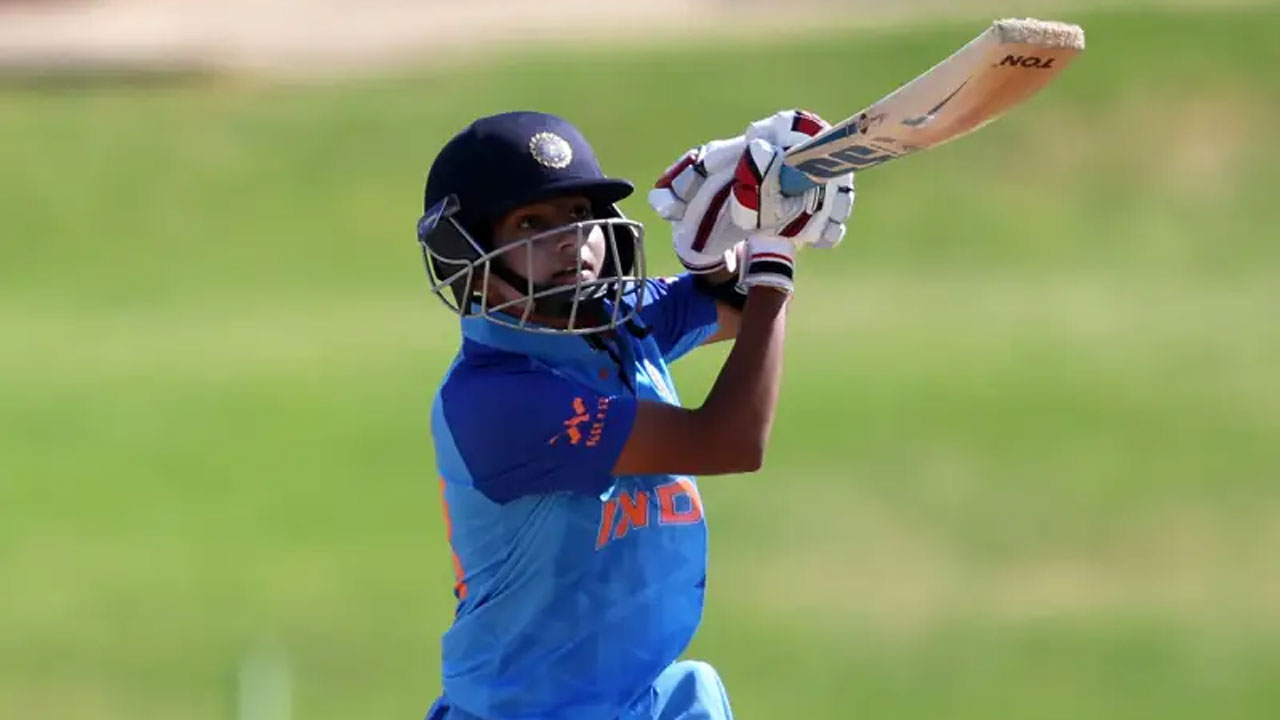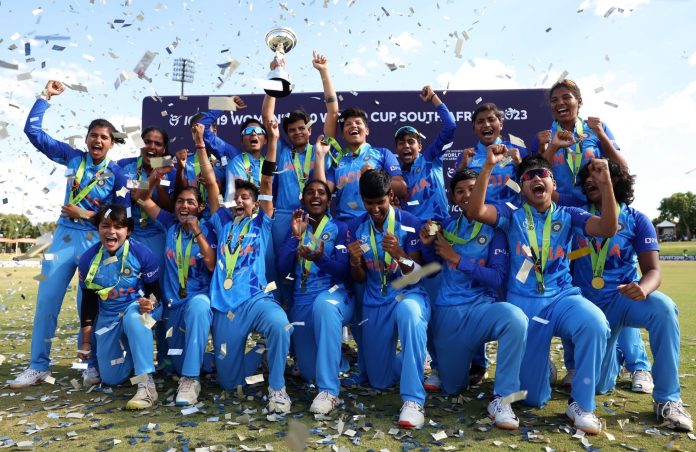India who lost their last three global finals in the last 6 years, finally broke the deadlock in the ICC U19 T20 World Cup 2023. As their U-19 side won the inaugural World Cup in South Africa. India earned a thumping victory by 7 wickets against England at Potchefstroom to win their first-ever Women’s World Cup in any format.
While this came along with the announcement of the Women’s Premier League, this could usher in a new era of women’s cricket. Along with the defeats against England in 2017, and against Australia in 2020, and 2022, Now India have something to cheer about when it comes to talking about the Final of the Tournament.
Shweta Sehrawat’s Majestic Form Continues:
There was a lot of discussion regarding the inclusion of Shafaali Verma and Richa, Ghosh’s inclusion in the U-19 team. Both the players, have the expertise and a lot of experience, playing on the senior side. While experts and fans expected that these two would carry the Indian batting, the opposition had no idea that they had a deal with another stalwart in making.
Shewta came into the tournament with a red-hot form. In the domestic Under-19 Trophy, she scored 180 runs with a strike rate of 128, while she topped the chart in U-19 Challenger with 163 runs. For the preparations for the World Cup BCCI organised several series as well. In one of these series against Srilanka and West Indies. They faced the wrath of Sehrawat as well. 164 runs came in 4 innings with a whooping strike rate of 152.
In the first match of the tournament against South Africa, chasing a total of 167, she announced her arrival on the big stage. Along with skipper Shafali Verma, she put up 77 runs for the first wicket in just 7 overs. While Shafali Verma was toying with the South African bowling, Shweta kept the scoreboard ticking with singles and occasional boundaries.
With her prowess on the offside, she took the South African attack by the neck, once Verma fell. Out of her unbeaten 92 from 57 balls, 80 runs came from boundaries. If the number of dot balls that Shweta consumed, was the only black spot of her innings, she rectified it in her 2nd outing against UAE. A 49-ball 74 was overshadowed by Shafali’s blistering knock with a strike rate of 230.
The opening partnership was 111 runs in 8 overs. While her supremacy at the top of the order was established, the Indian management asked her to bat down the order. Against Scotland, India tried with a new opening pair. After the initial hiccups, Gongadi Trisha and Richa Ghosh stabled the Indian innings. Shweta came to bat with 19 balls to spare.

Off-spinner Olivia Bell was hit for a four and a six in consecutive balls in the 18th over. But the best was yet to come for Sehrawat. Scotland skipper Katherine Fraser picked up Ghosh and Trisha in her last over and brought herself back for the last over. Sehrawat hit her back-to-back boundaries, followed by a six in the penultimate ball.
18 runs came from the last four balls. Sehrawat ended with a 10-ball 31. In three matches, the opposition found it difficult to cause any trouble for her. Though she scored only 21 against Australia, she was the top scorer for her side and her defiant 13 against Vihanga was crucial.
In the Semifinal against New Zealand, chasing a mere total of 108, on a spinning track, India lost skipper Shafali Verma, early once again. Shewta who is known for her ability to adapt to the situation proved her worth once again. While most of her runs came through boundaries, her running between the wickets is also worthwhile.
Unbeaten 61 from 45 balls which consisted of 10 boundaries led India to another victory. Though she fell for only 5 runs in the Final, trying to flick her counterpart, her tally of 297 runs was the highest in the tournament. Her average of 99 did not overshadow her strike rate of 139. She amassed 36% runs of the runs Indian batters made in the tournament.
Others Played Their Role As Well:
While Indian batting rode off the young shoulder of the Indian vice-captain, others played their supporting role in the given condition. Shafali Verma though was not her true colour apart from her first two matches, in those matches, she justified her reputation as one of the clean strikers of modern-day cricket.
Gongadi Trisha also hit a half-century against Scotland when she was promoted to bat up the order. Richa Ghosh’s 49 against UAE also helped India to go past the 200 runs mark.

Though Soumya Tiwari’s strike rate raised a few eyebrows, her calmness, when India lost two early wickets in the Final is noteworthy. Indian senior team is infamous for their collapse in the crunch situation and has lost matches like this before. But Tiwari’s unbeaten 24 from 37 with three boundaries guided India to a comfortable victory. Apart from her inning in the final, her unbeaten 28 from just 15 balls against Srilanka also debunk the ruses about the strike rate.
ICC U19 T20 World Cup 2023 Victory Was Not A Fluke:
It’s often argued why the Indian side collapse in the crunch situation. Rather than addressing the concern, the problem was put into reference while maintaining the status quo. Apart from the fewer matches, the Indian side gets, at any inconvenience, that the board faces, Women’s Cricket has been used as cannon fodder by the richest board in the World.
This U-19 World Cup can be used to voice what a perfect preparation looks like and what that can transpire when it comes to results. Indian side played the most number of the matches coming to the World Cup. The series includes New Zealand, South Africa, Srilanka and West Indies.
India won the series prior to the most coveted tournament. While teams like England and Australia mostly played domestic matches, India’s exposure to international match scenarios helped them to longer goals.
Apart from the support staff, and practice sessions at NCA, the legend of the game Mithali Raj travelled with the side as Mentor. Before the Final, Neeraj Chopra, the only Track and Field medalist for India in the Olympics, flew in for the pep talk.
Titas Sadhu Took The Charge Of Seam Bowling Attack:
One of the major factors that enhanced the Indian chance in the Final was Titas Sadhu’s opening spell. Winning the toss, India decided to bowl first. Despite her decent touch in the group matches, the wicket column didn’t do justice.
Titas’s spell of 4-0-6-2, not only checked the free flowing of the runs from one end but at the same time picked up two crucial wickets. England skipper Grace Scriven’s and Liberty Heap’s fearless approach was the taking point of the England batting.
The seamer from West Bengal caught Liberty Heap of her own bowling, in the very 2nd ball she faced. Heap was the 2nd highest scorer for England with a strike rate of 143. But her 2nd wicket of the tow became the ball so the Final. Shafali decided to give Sadhu consecutive four overs from one end.
𝐏𝐥𝐚𝐲𝐞𝐫 𝐨𝐟 𝐭𝐡𝐞 𝐌𝐚𝐭𝐜𝐡 – 𝐓𝐢𝐭𝐚𝐬 𝐒𝐚𝐝𝐡𝐮#U19T20WorldCup #U19WorldCup #u19WomensT20WorldCup #INDvENG #INDWvENGW #INDU19vENGU19 #CricketTwitter pic.twitter.com/8KQp4uNK2M
— Women's CricInsight | #T20WorldCup #WPL #WPL23 (@WCI_Official) January 29, 2023
Sadhu, in her very last over of the ICC U19 T20 World Cup 2023, bowled it on a length and got it to nip back in. It went past the bat of Smale, which came down at an angle to flick it through the leg side, to rattle the stumps. England was reduced to 22/4.
Titas picked up 6 wickets, but what was more important was her economy of 4.27, the 2nd lowest for India. While seamers like Falak Naz or Shabnam failed to make the cut and Hurley Gala was out due to an injury, Sadhu became the only prominent seamer of the side and she lived up to the occasion.
Indian Spinners Take Centre Stage:
On the surface, which turns out to be slow and produced tuns, opponents were bamboozled while facing the Indian spinners. Off Spinner Archana Devi, Left-arm spinner Mannat Kashyap and legspinner Parshavi Chopra, the famous spin trio collectively picked up 28 wickets.
Parshavi’s 4 wickets for just 5 runs against Srilanka was instrumental to restrict them to just 59 runs. In the semifinal, her three wickets included dangerous-looking Izzy Gaze’s wicket. Isabella Gaze and Georgia Plimmer had put off 37 runs by then. nd Gaze was the one who took the attack to the opposition.
2/13 in the Final, made her the highest wicket-taker for India, in the inaugural U-19 World Cup. Apart from her average of 7, she was the most economical bowler for India.
At the same time, she was well supported by Mannat Kashyap. India has a rich legacy of producing left-arm spinners on the senior side. Mannat took 4 wickets against Scotland, maintaining that legacy in the U-19 side. Apart from the Australia match, where she opened the bowling, she was also economical.
What A Catch! 🤩
Archana Devi took a one-handed stunner while Ryana Macdonald Gay tried to hit it off side.
ENG: 43-6 (11.1)#U19T20WorldCup #U19WorldCup #u19WomensT20WorldCup #INDvENG #INDWvENGW #INDU19vENGU19 #CricketTwitter pic.twitter.com/t4swqlfwEK
— Women's CricInsight | #T20WorldCup #WPL #WPL23 (@WCI_Official) January 29, 2023
Coming from Unnao Archana Devi’s mother was ostracized for allowing her girl to continue her studies and sports, after her father’s death. Archana took the cricket field to give a fitting reply. Her 8 wickets came with an economy of less than 5. While the batters find it difficult to hit them for a boundary, these spinners choked runs in the middle overs as well.
In the final of the ICC U19 T20 World Cup 2023, MacDonald-Gay managed to work Chopra’s fuller ball on off stump off her toes. But it was uppish towards extra cover, that Devi stepped in and launched herself into the air for a one-handed stunner. Indian skipper, Shafali Verma’s part-time spin also produced timely wickets which turned the flow of the games as well.
Get the latest news here, like us on Facebook, and follow us on Twitter and Instagram for more updates.

